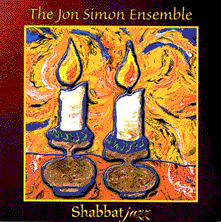 |
 |
http://www.jewishworldreview.com --
"HOW DO YOU handle the notes so well?" the listener asked the musician. "It
is not in the notes, but in the rests (pauses) between the notes, where the
art lies," he replied.
This story is related in the liner notes from "Shabbatjazz," the latest
release from Jon Simon. It is an album of music from and about that restful
pause at the end of each cacophonous week, our beloved Shabbat.
Ask Simon how he developed the idea of setting Jewish melodies to jazz
arrangements, and he tells another story. In his car one winter, Simon kept
cranking the radio dial, struggling to escape the Christmas songs. When he
finally did, he landed on "Maoz Tzur (Rock of Ages)," a Chanukah staple. But
he still wasn't happy, though now for a new reason. All the other holiday
songs, he realized, had contemporary arrangements. But this version of the
Chanukah staple sounded extremely dated.
Some, at this point, may have been content to frown or shrug. Instead, Jon
Simon was inspired. A budding jazz composer-Simon's first release, "images
and inspirations," included the score he wrote for the movie "Pandora's
Box"-Simon had received some studio time as a gift from his parents. He
entered with the idea of revitalizing Jewish melodies through jazz, and came
out with "new traditions," a recording that did just that. He followed it
with six more Jewish-jazz records, including "Zoom Gali Boogie."
Listen to select tracks by clicking here.
Classically trained, Simon fell into jazz as a teen. Like many musicians, he
hedged his bets with a fallback career. Simon's MBA is from Harvard, and his
bachelor's in industrial engineering from the University of Michigan. Even
today, Simon's Web site admits that he is a "senior executive and consultant
to Internet companies" around the U.S., and not just a brilliant pianist.
"I've had many influences, and try to expose myself to a lot of music,"
Simon explains. "Within jazz, I tend to gravitate toward Pat Metheny; I find
his music so rich and inventive. On keyboards, I've been drawn to... Keith
Jarrett, Chic Corea, Oscar Peterson and Bill Evans. Outside of jazz, I
actually listen to a lot of classical."
How does Jewish music fit in? The modal structure of Middle Eastern music is
very akin to those used in jazz, he explains, and Gershwin used the harmonic
structure of Jewish melodies in many of his compositions. "And cantors may
have been the first jazz musicians of all, improvising on the melodies of
the services," he adds.
Simon plays not Muzak jazz or intellectual progressive jazz, but the
accessible kind, exemplified by artists like Louis Armstrong, Ella
Fitzgerald, and Bobby McFerrin. His performances have won him acclaim both
wide and high at venues including the U.S. Senate, the Israeli Embassy, and
one of Clinton's Inaugural Galas.
Sure to increase Simon's standing even further, "Shabbatjazz" marks only the
second time he has recorded an entire album with a band, but the
arrangements are both sure-footed and free-flowing, with breathing space for
each note. Simon is able to increase speed without increasing volume, a
welcome relief. And the recording quality itself is superb.
"Shabbatjazz" begins and ends appropriately, bracketed by the snappy,
Latinate "Shabbat Shalom" and the nine-minute stream-of-consciousness "Adon
Olam." In between, we take "A Sabbath Walk" down Tin Pan Alley, kicking
autumn leaves into the breeze. We pray a "Hashiveinu" that gives sound to
the voiceless yearning of a heart pleading for forgiveness. We visit Debbie
Friedman in her "Mi Sheberach," and learn that her music deserves as much
notice as her songwriting.
And what would Shabbat be without guests? A bright flamenco guitar
introduces "Etz Chaim." A profound cello opens "Yedid Nefesh." A sprightly
flute helps close out the recording in "Adon Olam." And hand drums, used
throughout, nicely bridge the Latin and Middle Eastern elements of
"Shabbatjazz."
Perhaps the album's most innovative instrument, however, is the human voice.
Several pieces are warmed by vocal washes and descants-good alternatives to
the New-Agey synthesizers that often mar an otherwise solid sound.
While the other instruments delight, "Shabbatjazz" orbits around Simon's
stunning keyboard work. In case we forget, he reminds us in the middle of
"Adon Olam," where he breaks into a piano solo that both astonishes with its
dexterity and awes with its spirituality.
All the best elements come together on "Yom Ze Mechubad," the collection's
best track. The ancient melodic theme is evident, not hidden as on some
tracks. The sweeping vocals, the sparkling piano-each of the ideas that make
the individual tracks special join in one uplifting work. It is a
near-perfect piece of music.
Lots of Jewish music is appropriate for a campfire. Jon Simon's
music -- whether "Hanukkah and all that jazz,"
"From Broadway to Hollywood," or
"Beatles on Ivory" -- should be enjoyed by a

A day of rests, and notes:
Jon Simon's "Shabbatjazz"
By Paul Wieder
Perhaps because of the playful title, its festive lettering, or the splashy
suspenders and tie Simon sports on the cover, "Zoom Gali Boogie" often ends
up filed with the kids' music in the record store. Simon says it wasn't
intended that way, but he's fine with it; kids seem to enjoy the
polyrhythms, and he sometimes wins fans among their parents.
Silver Lining Records
Paul Wieder is a public relations associate at the Jewish United Fund and a columnist for
JUF News. Contact the author or the magazine by either clicking here, or calling (312) 444-2853.
